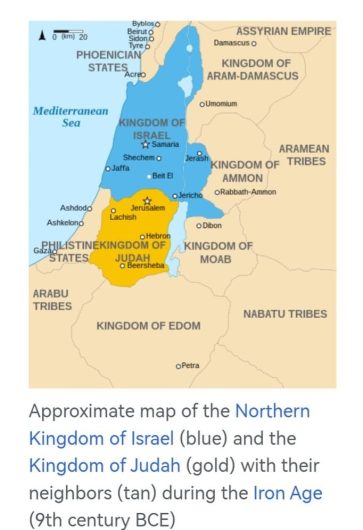Much of what scholars know about Israel’s ancient history comes from the Hebrew Bible. According to the text, Israel’s origins can be traced back to Abraham, who is considered the father of both Judaism (through his son Isaac) and Islam (through his son Ishmael).
Abraham’s descendants were thought to be enslaved by the Egyptians for hundreds of years before settling in Canaan, which is approximately the region of modern-day Israel.
The word Israel comes from Abraham’s grandson, Jacob, who was renamed “Israel” by the Hebrew God in the Bible.
King David and King Solomon
King David ruled the region around 1000 B.C. His son, who became King Solomon, is credited with building the first holy temple in ancient Jerusalem. In about 931 B.C., the area was divided into two kingdoms: Israel in the north and Judah in the south.
Around 722 B.C., the Assyrians invaded and destroyed the northern kingdom of Israel. In 568 B.C., the Babylonians conquered Jerusalem and destroyed the first temple, which was replaced by a second temple in about 516 B.C.
For the next several centuries, the land of modern-day Israel was conquered and ruled by various groups, including the Persians, Greeks, Romans, Arabs, Fatimids, Seljuk Turks, Crusaders, Egyptians, Mamelukes, Islamists and others.
The history of ancient Israel and Judah begins in the Southern Levant region of Western Asia during the Late Bronze Age and Early Iron Age. “Israel” as a people or tribal confederation appears for the first time in the Merneptah Stele, an inscription from ancient Egypt that dates to about 1208 BCE, with the people group possibly being older. According to modern archaeology, ancient Israelite culture developed as an outgrowth from the Semitic Canaanites. Two related Israelite polities known as the Kingdom of Israel (Samaria) and the Kingdom of Judah had emerged in the region by Iron Age II.
According to the Hebrew Bible, a “United Monarchy” (consisting of Israel and Judah) existed as early as the 11th century BCE, under the reigns of Saul, David, and Solomon; the country later would split into two separate kingdoms: Israel, containing the cities of Shechem and Samaria in the north, and Judah (containing Jerusalem and the Jewish Temple) in the south. The historicity of the United Monarchy is debated—as there are no archaeological remains of it that are accepted as consensus—but historians and archaeologists agree that Israel and Judah existed as separate kingdoms by c. 900 BCE[1]: 169–195 [2] and c. 850 BCE,[3] respectively.[4]
The Kingdom of Israel was destroyed around 720 BCE, when it was conquered by the Neo-Assyrian Empire.[5] While the Kingdom of Judah remained intact during this time, it became a client state of first the Neo-Assyrian Empire and then the Neo-Babylonian Empire. However, Jewish revolts against the Babylonians led to the destruction of Judah in 586 BCE, under the rule of Babylonian king Nebuchadnezzar II. According to the biblical account, the armies of Nebuchadnezzar II besieged Jerusalem between 589–586 BCE, which led to the destruction of Solomon’s Temple and the exile of the Jews to Babylon; this event was also recorded in the Babylonian Chronicles.[6][7]
The exilic period, which saw the development of the Israelite religion (Yahwism) towards the distinct monotheism of Judaism, ended with the fall of Babylon to the Achaemenid Persian Empire around 538 BCE. Subsequently, Persian king Cyrus the Great issued a proclamation known as the Edict of Cyrus, which authorized and encouraged exiled Jews to return to Judah.[8][9] Cyrus’ proclamation began the exiles’ return to Zion, inaugurating the formative period in which a more distinctive Jewish identity was developed in the Persian province of Yehud. During this time, the destroyed Solomon’s Temple was replaced by the Second Temple, marking the beginning of the Second Temple.
Historians date Abraham’s biblical story around 2000 B.C., based on clues in Genesis Chapters 11 through 25. Considered the first of the biblical patriarchs, Abraham’s life history encompasses a journey starts that in a place called Ur. In Abraham’s time, Ur was one of the great city-states in Sumer, a part of the Fertile Crescent located from the Tigris and Euphrates Rivers in whats called Iraq today to the Nile in Egypt. Historians call this era from 3000 to 2000 B.C. “the dawn of civilization” because it marks the earliest documented dates when people settled in communities and began such things as writing, agriculture, and commerce.
The Balfour Declaration
From 1517 to 1917, what is today Israel, along with much of the Middle East, was ruled by the Ottoman Empire.
But World War I dramatically altered the geopolitical landscape in the Middle East. In 1917, at the height of the war, British Foreign Secretary Arthur James Balfour submitted a letter of intent supporting the establishment of a Jewish homeland in Palestine. The British government hoped that the formal declaration—known thereafter as the Balfour Declaration—would encourage support for the Allies in World War I.
When World War I ended in 1918 with an Allied victory, the 400-year Ottoman Empire rule ended, and Great Britain took control over what became known as Palestine (modern-day Israel, Palestine and Jordan).
The Balfour Declaration and the British mandate over Palestine were approved by the League of Nations in 1922. Arabs vehemently opposed the Balfour Declaration, concerned that a Jewish homeland would mean the subjugation of Arab Palestinians.
The British controlled Palestine until Israel, in the years following the end of World War II, became an independent state in 1948 declaration of independence.
https://en.m.wikipedia.org/…/History_of_ancient_Israel…
https://www.history.com/…/middle-east/history-of-israel…
We continue to pray for PEACE in GAZA and ISRAEL and the restoration of all damage caused by the HAMAS attack on Israel. Sadly, innocent lives are lost, and many are injured and displaced from their homes. We pray for all of GOD’S children to be provided for during this time of needs.
COOL with us.
Gavin Ferrier
Pastor Gavin Ministries – COOL Ministries International


